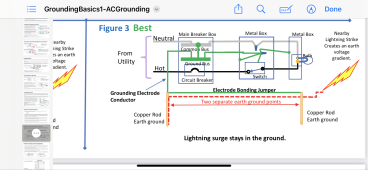Hello,
I have a 4400 W magnum inverter charger with a mini panel. This is my main panel so it is grounded to the earth. The main panel is located in my attached garage. I have a sub panel for the house AC and another sub panel/remote panel in an outbuilding that is about 50 feet from the garage. The outbuilding panel is earth grounded and my solar array which is about 50 feet from the outbuilding also has an earth ground.
Everything has lightning protection including the pportable generator attached to the Inverter charger.
If I’m understanding Will’s video correctly the way I have the earth grounds set up it could cause damage to my equipment if there was a lightning strike?
Thank you
I have a 4400 W magnum inverter charger with a mini panel. This is my main panel so it is grounded to the earth. The main panel is located in my attached garage. I have a sub panel for the house AC and another sub panel/remote panel in an outbuilding that is about 50 feet from the garage. The outbuilding panel is earth grounded and my solar array which is about 50 feet from the outbuilding also has an earth ground.
Everything has lightning protection including the pportable generator attached to the Inverter charger.
If I’m understanding Will’s video correctly the way I have the earth grounds set up it could cause damage to my equipment if there was a lightning strike?
Thank you



